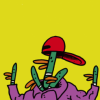-
Posts
352 -
Joined
-
Last visited
Content Type
News Articles
Tutorials
Forums
Downloads
Everything posted by redsaurus
-
You could alternatively target the concealed switch at a target_deactivate which then uses the trigger_once.
-
I think I'll definitely try to get the noghri stick and tusken rifle usable by the player, there shouldn't be too much work needed.
-
Don't worry, you're not imagining it, the SFX sabers do cast a bit more light than the normal sabers. In the code the light intensity is set a little higher than the base sabers' intensity.
-
Do you mean no twirl when turning the saber on and off? Or anything else?
-
Which build are you using exactly @@Circa? How exactly can I reproduce that? JA+ *should* work alright with OpenJK from #jacoders: Ensiform: cl_consoleKeys defines the console keys available with SDL backend
-
Anything new with new levels? I was thinking that if I fix the vehicles up a bit more in SP siege_destroyer could be made into a level. @@Pande's dotf could form the basis for a nice naboo level too?
-
I've hopefully fixed the crash now @@Aidor @@Angel Soul, so it's time for beta 4 release. Sorry I didn't get the fix released for a few days. Here's the new release for Mac/Windows (39.8MB). If you don't already have it (and you're on Windows) you'll need the MSVC++ 2010 redistributable (http://www.microsoft.com/en-gb/download/details.aspx?id=5555) Most features are exactly the same as in the last release (http://jkhub.org/topic/2480-sp-customisation-stuff/page-9?do=findComment&comment=74661) so I won't repeat them. Credits are there too! (as well as in the read me of course) New features: .eent files Maps now load entities from mapentities/mapname.eent in addition to loading them from the .bsp file.As the mod uses the latest OpenJK code, vehicles will be working very slightly better than in base SP.
-
Since the hosting and domain name was changed I doubt there are still issues with NOD32.
-
Could you check if it still crashes for you with an otherwise clean base?
-
Saberthrow is +button9 now. Have you got an edited weapons.dat? If you do you'll need to add the worldmodel lines from the sp_custom.pk3 to your weapons.dat. Not sure about the crashing really, hope that fixes it.. @@therfiles I think that the NPC head swapping should partially work, but it might only turn off sub surfaces of one called "head", so may not work properly with some custom models. If it still leaves the head on base models like luke etc then I'll fix it fairly soon, otherwise a workaround for now is just to have a custom skin file with the head surfaces turned off. There will be improvements to the NPC part swapping eventually anyway.
-
Of course! You can get the source from the custom branch of my OpenJK fork - here's the list of changes: https://github.com/redsaurus/OpenJK/compare/custom Yeah, the detached eweb is slightly overpowered Walk only & no jump etc. (unless you're using force speed maybe?) would definitely be a good idea.
-
I only flipped it in blender to test things out, you'll have to make the change yourself. Currently I'm adding a slight extra offset (of 1 unit) out from the hips tag, but that might change in the future. Here's the new release for Mac/Windows (39.6MB). If you don't already have it (and you're on Windows) you'll need the MSVC++ 2010 redistributable (http://www.microsoft.com/en-gb/download/details.aspx?id=5555) Features and Commands • All OpenJK features and fixes.• RGB Sabers The can be set in the menus or by setting the sabercolor to a hex code in the console - for example "/sabercolor 1 xff0000" will set the first lightsaber blade to be red. It should be possible to set the sabercolours of NPCs by setting their sabercolor to a hex code in the .npc file.• SFX Sabers SFX Sabers can be enabled in the console by setting cg_SFXSabers to 1.• Ignition Flare A lightsaber ignition flare can be enabled in the console by setting cg_ignitionFlare to 1.• Custom Sabers Now lightsabers can be customised like the player species. An example customisable hilt is included thanks to AshuraDX.• Saber Holsters Lightsabers are now holstered when not in use. A tag_holsterorigin can be added to a hilt for better placement. Adding "holsterPlace <none/hips/back>" in the .sab file specifies where a hilt will be holstered.• Headswapping Several new heads are available for the human male and human female species. You can add your own heads - see the .headswap files in the sp_custom.pk3 for examples. NPCs can have heads set using the playerHeadModel and customHeadSkin commands in their .npc file.• Better Entity Spawning The /spawn command now supports entity keys, e.g. "spawn fx_runner fxFile the/file".• Raz0r's MP Movement Raz0r's MP-style movement from the SP speedrun version can be enabled by getting g_MPmovement to 1.• Extra Player Tints (Unused) Playermodels are able to have multiple tints. If you enter “newPlayerTint 0 <R> <G> <B>”, any shader stages for the player with “rgbGen lightingDiffuseEntity 0” will be tinted to this colour rather than the usual.• Ghoul2 view models First person view weapon models are now allowed to use .glm models using eezstreet's code.• Detachable E-Web The player can detach an E-Web from its mount by pressing the Use Force button whilst using it.• Improved jedi_hm DT's very nice improved Human Male jedi is included.• Katarn Saberstyle A gun / saber stance. Not completely ready yet, but you play around with it (with cheats enabled) by doing "give weapon_bryar_pistol" and then "setsaberstyle katarn" in the console.• Saberthrow Saberthrow is now a force power. Credits Thanks to AJL for the SFX Sabers stuff (including SFX_Sabers.pk3). Thanks to @@Circa for the icons for the new heads. Thanks to @@Raz0r for the MP-style movement code. Thanks to @@AshuraDX for the saber hilt. Thanks to @@DT85 for the improved jedi_hm. Thanks to the JKG team for the unstable saber blade graphics and shaders. Thanks to @@eezstreet for the Ghoul 2 weapon view model code. Thanks to the OpenJK maintainers and contributors. Let me know if anything doesn't work etc. The hud stuff hopefully will be working properly now @@therfiles as it's fixed (afaik) in OpenJK now.
-
ok, I finally have tag_holsterorigin working properly (but the tags should be upside down from where your tag on the zefilus hilt was @@Rooxon). I'll do some menu files changes then do a release.
-

The Sp mission replace with another mission
redsaurus replied to Langerd's topic in Mod Requests & Suggestions
If you'd be interested in including your level in JK:E (and possibly my sp customisation mod in the meantime) I can see about making it easier to add stuff to tiers on the code side of things -
Thanks, that's useful, I've started investigating and it seems like it actually sort of works in base! It will show up on the loading screen in base if "player" is "luke", but just not in-game. Hopefully it shouldn't be too hard to sort out. One possible solution might be to have a hud2.menu or similar that's also drawn from and leave the hud.menu to store all the positions of stuff. I quickly made some improvements to holstering so you can set holsterPlace <none/hips/back>in the .sab file. Defaults to hips unless it's the sith sword. The player doesn't do the twirl when holstering the saber anymore either. Definitely planning to do a release soon. EDIT: I think I've found a way to fix the thing showing up on the loading screen @@therfiles - I'll have a release out in the next few days.
-
Mind putting the hud.menu up somewhere temporary @@therfiles so I can have a play around with it? I've also made the changes from @@eezstreet's g2 view model stuff to my branch, so afaik it supports them now (haven't actually tested it yet though, don't have a model to test with...)
-
I've finished the eweb detach thing for now - when you change weapons away from it you automatically drop it on the ground. I think it's probably a tiny bit overpowered. It looks like @@eezstreet already made it so there can be extra hud elements in OpenJK, so that should already be included in this mod. // Draw all the HUD elements --eez cgi_UI_Menu_Paint( cgi_UI_GetMenuByName( "lefthud" ), qtrue ); If it's not working / doesn't do everything you want to be able to do I can see what I can do though.
-
-
For the next release I'll just use the ignition flare I showed (but with the right colour), but I might well put the nicer ones in later, thanks @@Serenity937. That means things are looking a bit like this: Changes since last release: Small bugfixesSaberthrow is now a force power - use it with +button9Better saber holster placementNicer RGB saber menusAdded ignition flareAdded @@DT85's nicer jedi_hmAn early version of katarn saberstyleAdjustable saber radius for SFX sabersbeing able to detach the eweb from the mount and carry it round support for eezstreet's .glm viewmodelsoption to not holster a saber in .sab filefixed tag_holsteroriginWIP / todo - some may be for later releases: sabercolorRGB field for .npc and .sab files, so they can still have roughly the correct colour in basesaber crystals - have done black sabers and unstable blades so far but haven't finished up the mechanics entirely. idea as in JK:E discussions: you'll be able to pick some crystals up in secret areas that allow you to have special sabers when building saber #2, like the darksaber and unstable bladesfix SFX saber end being past the blade endRGB sliders in player menusragdoll mode with head swaps is a little brokenallow the second saber to be a custom sabershow SFX sabers in menusadd menus for all the cvars I've addedswap non-head partsAny ideas / suggestions / things I've missed?
-
ok, I'll change the flare graphics and make it the same colour as the saber.
-
Here's the ignition flare..I'm wondering if it should be whiter or slightly tinted to the saber colour.
-

Request for RGB lightsaber in SP
redsaurus replied to BrudasekPL's topic in Mod Requests & Suggestions
What's the exact message? Do you still get the problem with a clean base folder? I think that my last release had a slight problem with saber colours when loading from saved games (fixed for next version), but there shouldn't be any problems just on map change. -
I've now added ignition flares and cvars to change the size of the core/glow for SFX sabers. I've also got the gun/saber style working a little better. Anything else need doing before release?
-

Request for RGB lightsaber in SP
redsaurus replied to BrudasekPL's topic in Mod Requests & Suggestions
Good to hear that it works now! -

Request for RGB lightsaber in SP
redsaurus replied to BrudasekPL's topic in Mod Requests & Suggestions
What exactly are you doing? Just to check: you're selecting the RGB saber icon (the white one), then you are moving the sliders in the box around? If you have another UI mod that contains the ui/menus.txt file then the pop up will not work, the mod isn't compatible.



